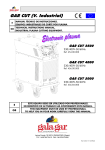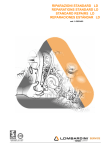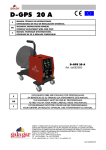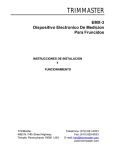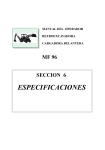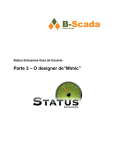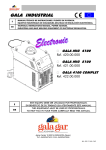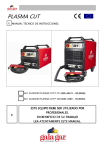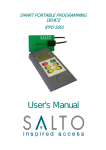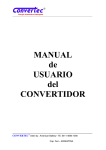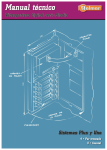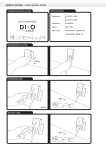Download GAR CUT 550 (V. Profesional)
Transcript
GAR CUT 550 (V. Profesional) MANUAL TÉCNICO DE INSTRUCCIONES. EQUIPOS PROFESIONALES DE CORTE POR PLASMA. TECHNICAL INSTRUCTIONS MANUAL. GB PROFESSIONAL PLASMA CUTTING EQUIPMENT. E GAR CUT 550 E GB 230/400 V 50 Hz. Ref. 457.00.000 ESTE EQUIPO DEBE SER UTILIZADO POR PROFESIONALES. EN BENEFICIO DE SU TRABAJO LEA ATENTAMENTE ESTE MANUAL. THIS EQUIPMENT MUST BE USED BY PROFESSIONALS. TO HELP YOU IN YOUR WORK CAREFULLY READ THIS MANUAL. Jaime Ferrán 19 50014 ZARAGOZA (Spain) TLF.-34/976473410 FAX.-34/976472450 Ref. 457.17.147/Ed. 2 GAR CUT (V. PROFESIONAL) E ÍNDICE DE TEMAS. CAPITULO 1. DESCRIPCIÓN GENERAL. CARACTERÍSTICAS TÉCNICAS ............................. Pág. 3 CAPITULO 2. TRANSPORTE E INSTALACIÓN ................................................................... Pág. 4 CAPITULO 3. PUESTA EN MARCHA. FUNCIONAMIENTO Y REGLAJES .............................. Pág. 5 CAPITULO 4. OPERACIONES DE MANTENIMIENTO. RECOMENDACIONES ..................... Pág. 8 CAPITULO 5. ANOMALÍAS. CAUSAS PROBABLES. SOLUCIONES POSIBLES ...................... Pág. 9 CAPITULO 6. MEDIDAS DE SEGURIDAD .......................................................................... Pág. 11 ANEXOS. .................................................................................................................. Pág. 23 - DECLARACIÓN DE CONFORMIDAD MARCADO CE. - PLANOS ELÉCTRICOS. - PLANOS DE DESPIECE Y LISTAS DE REFERENCIAS. FORMULACIÓN PARA REALIZAR PEDIDOS DE PIEZAS DE REPUESTO: Indique: 1º Maquina, Referencia y Nº de serie. 2º Tensión de Alimentación/Frecuencia. 3º Nº de piezas, descripción y referencia de las mismas. EJEMPLO: GAR CUT 550, Ref. 457.00.000 (230/400V-Mohs) lid MANÓMETRO, Ref.457.16.220 GB CONTENTS. CHAPTER 1. GENERAL DESCRIPTION. TECHNICAL CHARACTERISTICS. ......................... Page 13 CHAPTER 2. TRANSPORT AND INSTALLATION ............................................................... Page 14 CHAPTER 3. START-UP. ADJUSTMENT AND OPERATION CONTROLS. ............................ Page 15 CHAPTER 4. MAINTENANCE OPERATIONS. RECOMMENDATIONS. .............................. Page 18 CHAPTER 5. ANOMALIES. PROBABLE CAUSES. POSSIBLE SOLUTIONS. .......................... Page 19 CHAPTER 6. SAFETY MEASURES ..................................................................................... Page 21 APPENDICES. .................................................................................................................. Page 23 - DECLARATION OF CONFORMITY & EC MARKING - ELECTRICAL DRAWINGS. - DETAIL DRAWINGS AND REFERENCE LISTS. FORMULA FOR MAKING ORDERS FOR SPARE PARTS: Indicate: 1º. Machine, Reference and Serial no. 2º. Supply Voltage / Frequency. 3 - No. of parts, description and reference of it. EXAMPLE: GAR CUT 550, Ref. 457.00.000 (230/400V-Mohs) Lid PRESSURE GAUGE, Ref. 457.16.220. 2 GAR CUT (V. PROFESIONAL). Manual de Instrucciones. 3 CAPITULO 1. DESCRIPCIÓN GENERAL. CARACTERÍSTICAS TÉCNICAS. Las máquinas GAR CUT (V. Profesional) realizan la función de corte por plasma eléctrico soplado con aire comprimido. Pueden cortar todo tipo de materiales conductores de la electricidad: Acero, acero inoxidable, aluminio, latón, etc. Tabla Nº 1. Espesores máximos de corte. GAR CUT 550. ESPESOR MÁXIMO ACONSEJADO ESPESOR LIMITE ACERO DULCE 10 mm. 12 mm. ACERO INOXIDABLE 10 mm. 12 mm. ALUMINIO 6 mm. 7 mm. La antorcha de corte y la toma de masa forman parte de la máquina. No se pueden separar sin desmontar. Estos equipos disponen de protección contra: sobrecalentamientos, falta de presión en el circuito neumático, sobrecargas en el circuito de control, y contactos con tensiones peligrosas durante la sustitución de componentes de la cabeza de la antorcha. Tabla Nº 2 . Características Técnicas. Tensión alimentación (U1–3Ph 50 Hz) Intensidad primaria máxima (I1max ) Intensidad primaria efectiva (I1eff) Tipo de gas de entrada. Presión de trabajo Caudal nominal de entrada Con el equipo se suministran: Posiciones de regulación - Antorcha de corte de conexión directa. - Cable de masa de conexión directa. - Gafas de protección. Encendido antorcha Espesor máximo de corte PARA LA UTILIZACIÓN DE CUALQUIER OTRO ACCESORIO CONSULTE CON EL FABRICANTE. GAR CUT 550 Ref. 457.00.000 CARACTERÍSTICAS TÉCNICAS Aislamiento térmico Ventilación Grado de protección. Peso Norma de aplicación Fig. 1 - Dimensiones del equipo GAR CUT (V. Profesional). 230/400 V 33/19 A 19/11 A AIRE 5-5,5 bar 120 l/min I II 28 A (100%) 47 A (35%) H.F 12 mm H (180ºC) FORZADA IP 21 67 KG. EN 60974 GAR CUT (V. PROFESIONAL) Manual de Instrucciones. 4 CAPITULO 2. TRANSPORTE E INSTALACIÓN. En el transporte del equipo deben evitarse los golpes y los movimientos bruscos. La posición de transporte será siempre vertical. Debe protegerse al embalaje de la caída de agua. -Instalación eléctrica. Interruptor magnetotérmico. 230 V 25A Manguera de alimentación: EN CASO DE UTILIZAR UNA TRANSPALETA PARA LA ELEVACIÓN, VIGILE LA ESTABILIDAD DEL EQUIPO. Una vez desembalado el equipo puede procederse al montaje de pie, eje, ruedas y asa. Fig. 2. Montaje de pie, eje, ruedas y asa. 400 V 15A Longitud 10 m >15 m SECCIÓN 230 V 400 V 4 mm2 2,5 mm2 6 mm2 4 mm2 Los equipos de la serie GAR CUT (V. Profesional) son bitensión 230-400V. Por ello es preciso comprobar que la tensión seleccionada en el equipo coincide con el voltaje de la red. Los equipos standard salen de fábrica con el selector de tensión a 400 V con el fin de proteger a los mismos frente a descuidos en la conexión. Para cambiar a la tensión de 230 V siga las instrucciones indicadas en la figura 3. ( El procedimiento será el mismo en caso de tensiones especiales). Fig. 3 Cambio de tensión. Pos 2 Pos 1 T 1º. Colocar el tornillo T en la posición 2. 2º. Para conectar el equipo accionar la maneta a la posición 230 V. Se debe tener colocado siempre el tornillo T, de esta forma se evitarán deterioros en el equipo por descuidos en la conexión. NO OLVIDE CONECTAR LA TOMA DE TIERRA EN LA CLAVIJA. 2.2 INSTALACIÓN NEUMÁTICA. Capacidad mínima de la instalación 150 l/mín (5,5 bar). 2.1 INSTALACIÓN ELÉCTRICA. El emplazamiento deberá cumplir los siguientes requisitos: - Lugar: Seco y ventilado. alejado suficientemente del puesto de corte con el fin de evitar que el polvo metálico originado en el proceso pueda introducirse en el equipo. La toma neumática puede realizarse directamente del circuito de aire comprimido, aunque es recomendable que si el aire contiene un porcentaje considerable de humedad o aceite, se coloque un secador y/o filtro en la entrada. De esta forma evitaremos fallos de encendido de arco así como un desgaste prematuro de los elementos consumibles (electrodo y tobera). GAR CUT (V. PROFESIONAL) Manual de Instrucciones. 5 CAPITULO 3. PUESTA EN MARCHA. FUNCIONAMIENTO Y REGLAJES. 3.1 MANDOS DE OPERACIÓN. Fig. 4 - Frontal equipo GAR CUT (V. Profesional) L1 L3 F1 F2 L2 I1 - Interruptor General de puesta en marcha. I2- Conmutador selector de la potencia de corte. Pos 1. Corte de acero hasta 6 mm. Pos 2. Corte de acero hasta 12 mm. F1, F2- Fusibles de protección del circuito de control. L1- Lamparita verde indicadora de estado de conexión "ON". I1 L2- Lamparita roja indicadora de desconexión del equipo por falta de presión. L3- Lamparita ámbar indicadora de desconexión de equipo por sobrecalentamiento. M- Manómetro indicador de presión de aire. SP- Salida de antorcha de corte. I2 M SM SP SM- Salida del cable de masa. 3.2 PROCESO DE PUESTA EN MARCHA. La utilización de la máquina debe quedar restringida al menor número de personas. Debe evitarse el empleo del equipo por personal no adiestrado. La secuencia para realizar la puesta en marcha del equipo es la siguiente: ⇒ Conectar el interruptor general I1 en la posición de encendido (I). La lámpara verde L1 se ilumina. (Comprobar que el sistema de bloqueo selector de tensión está bien colocado) ⇒ Comprobar que las lámparas roja y ámbar no están iluminadas. ⇒ Determinar mediante I2 la potencia de corte adecuada. ⇒ Oprimir brevemente el pulsador de la antorcha. Comenzará a existir flujo de aire. ⇒ Comprobar que la presión del manómetro posterior está comprendida entre 5,3 y 5,5 bar. Debe existir flujo de aire. ⇒ Oprima el pulsador de la antorcha. Se formará el arco. Ya puede comenzar a cortar. MANTENGA EL CONTACTO DE LA TOBERA CON LA PIEZA A CORTAR. GAR CUT (V. PROFESIONAL) Manual de Instrucciones. 6 3.3 PROCESO DE CORTE. RECOMENDACIONES GENERALES. ) Antes de proceder a realizar el corte debe determinarse la intensidad de corte adecuada en función del trabajo a ejecutar. ) Al insertar un electrodo nuevo en la antorcha de corte proceda a un cepillado que elimine posibles capas aislantes superficiales. & "Saque brillo al electrodo". Realice esta operación siempre que observe problemas en la ignición de arco ) ) ) Forme el arco piloto fuera de la pieza. Con anterioridad a la formación del arco oprima brevemente el pulsador con el fin de tener caudal de aire previo. Si tras la realización de un proceso de corte de duración considerable, observamos un cierto calentamiento en la antorcha de corte, aconsejamos dejar que el post-flujo de aire refrigere la antorcha. Mantenga el contacto de la tobera con la pieza de corte. A medida que la tobera de la pieza a cortar, disminuye la potencia de corte. ) Determine la velocidad de corte adecuada. La penetración así como la rebaba de corte dependen directamente de la velocidad imprimida en el proceso. Se considera como velocidad correcta aquella que provoca una inclinación máxima del arco proyectado con respecto a la perpendicular de la pieza de 7 a 15º. ) Cuando vaya a finalizar la operación de corte, (sin dejar de oprimir el pulsador) separe la antorcha de la pieza, el arco se extinguirá automáticamente. Con esta acción aumentamos la vida del contactor principal del equipo. , No realizar ninguna acción sobre los conmutadores de mando durante la realización del proceso de corte. , Cualquier elemento accesorio o instalación que se añada al equipo deberá permitir mantener las condiciones de seguridad de partida del equipo. Todos los equipos añadidos deberán cumplir las Normas y Reglamentaciones vigentes. ) No prolongue la acción del arco piloto más de tres segundos. 3.4 CICLO DE CORTE REALIZADO POR EL EQUIPO GAR CUT 550. REGLAJE DE PARÁMETROS. AJUSTES EN LA PLACA ELECTRÓNICA. SOLO REALIZABLE POR PERSONAL ESPECIALIZADO. SERVICIO DE ASISTENCIA TÉCNICA. Fig. 5 - Aspecto de la placa electrónica SCP-1. Una vez se oprime el pulsador de la antorcha el sistema de control electrónico del equipo GAR CUT comienza la realización de lo que denominamos ciclo de corte. En la placa electrónica existen unos trimmers de regulación que controlan los tiempos de cada fase del ciclo . - TRIMMERS DE REGULACIÓN. - Tpsf : Trimmer de regulación del tiempo de la fase de post-flujo. - Tprf : Trimmer de regulación del tiempo de la fase de preflujo - Th.f : Trimmer de regulación del tiempo de actuación del sistema de ignición mediante HF. Tpsf = 45 sg. Tprf = 0.3 sg. Thf = 1.5 sg GAR CUT (V. PROFESIONAL) Manual de Instrucciones. 7 3.5 RECOMENDACIONES RELATIVAS AL CICLO DE CORTE. , Los reglajes correctos de los tiempos señalados son fundamentales para un perfecto funcionamiento del equipo. En la GAR CUT 550 debe existir aire antes de que se produzca la ignición de arco , en caso contrario se produciría un grave deterioro de la cabeza de la antorcha a causa de la formación interior del arco eléctrico. El tiempo que transcurre entre la aparición de aire y la ignición del arco es lo que hemos denominado preflujo. Proponemos la rutina de pulsar brevemente el pulsador con el fin de provocar la salida de aire sin producir la ignición. Una vez comprobada la existencia de aire ya podemos provocar la ignición del arco pulsando continuadamente. ) ) Así mismo el tiempo de post-flujo tiene gran importancia de cara a la vida útil de la antorcha de corte. Este tiempo delimita el grado de refrigeración de la antorcha después de haber realizado un proceso de corte. No aconsejamos la reducción del valor por debajo de 40 segundos. No prolongue la acción del arco piloto más de tres segundos. , Utilizando tobera y electrodos largos debe incorporarse, por motivos de seguridad, la caperuza de protección Ref. 51965/G. 3.6 ELEMENTOS DE PROTECCIÓN INTERNA. Los equipos de corte por Plasma GAR CUT 550 disponen de los siguientes elementos de protección interna: - PROTECCIÓN FUSIBLE: Se dispone de dos fusibles de protección F1: 0.5A/250V y F2 1A/250V. F2: Protege al circuito de control de sobrecargas. En caso de encontrarse "saltado" la lámpara ON/OFF L1 se encontrará apagada no girando además el ventilador. F1: Protege al circuito generador de alta frecuencia de sobrecargas. - PROTECCIÓN CONTRA SOBRECALENTAMIENTOS EN EL TRANSFORMADOR.(L2). En el momento que el transformador alcanza una temperatura elevada, se activa un mecanismo de protección que impide la continuación de la operación de corte, esto queda indicado mediante la lamparita ámbar L2 situada en el frontal de la máquina, que quedará iluminada no existiendo ciclo de corte. - PROTECCIÓN CONTRA LA AUSENCIA DE PRESIÓN EN CIRCUITO NEUMÁTICO. Es importante que el caudal de aire en la salida de la antorcha corresponda al marcado en la tabla Nº 2 , con el fin de evitar un deterioro por sobrecalentamiento de la antorcha. En el interior de la máquina existe un presostato que impide la operación de corte si la presión de entrada no se encuentra por encima de un valor límite. Esto queda indicado por una lamparita testigo roja L2 que permanecerá encendida si la presión no es la correcta. El presostato del equipo se encuentra en el interior del equipo adyacente al filtro regulador. Este presostato dispone de un tornillo de regulación que permite fijar el valor de la presión mínima ( alrededor de 4.5 bar). - PROTECCIÓN CONTRA CONTACTOS DIRECTOS EN EL CUERPO DE LA PISTOLA. Con el fin de evitar que en la operación sobre el cuerpo de la antorcha (sustitución de componentes consumibles, por ejemplo.), puedan existir tensiones peligrosas, la antorcha dispone de un sistema de seguridad (accionado por la portatobera) que anula la acción del pulsador. No obstante debe tenerse muy presente que la operación sobre el cuerpo de la antorcha debe realizarse siempre con la MAQUINA DESCONECTADA . GAR CUT (V. PROFESIONAL) Manual de Instrucciones. 8 CAPITULO 4. OPERACIONES DE MANTENIMIENTO. RECOMENDACIONES. Con el fin de proporcionar una larga vida al equipo deberemos seguir unas normas fundamentales de mantenimiento y utilización. Atienda estas recomendaciones. UN BUEN MANTENIMIENTO DEL EQUIPO EVITARA UN GRAN PORCENTAJE DE AVERÍAS. 4.1 MANTENIMIENTO DE LA MAQUINA. RECOMENDACIONES GENERALES. Antes de realizar cualquier operación sobre la máquina o la antorcha, debemos colocar el interruptor I1 del equipo en la posición "O" de máquina desconectada. La intervención sobre la máquina para la realización de operaciones de mantenimiento y reparación, debe realizarse por personal especializado. ) SOPLE PERIÓDICAMENTE CON AIRE COMPRIMIDO EL INTERIOR DE LA MAQUINA La acumulación interior de polvo metálico es una de las principales causas de averías en este tipo de equipos ya que están sometidos a una gran polución originada en el proceso de corte. Como medida fundamental debe separarse el equipo del lugar de corte, evitando una colocación a corta distancia. Mantener la máquina limpia y seca es fundamental. Debe soplarse el interior con la frecuencia que sea necesaria. Debemos evitar cualquier anomalía o deterioro por la acumulación de polvo. Sople con aire comprimido limpio y seco los dos volúmenes interiores del equipo. - Volumen de control (superior) : Placas electrónicas, contactores, transformador auxiliar, interruptores. - Volumen de potencia (inferior): Rectificador, transformador principal. )MANTENGA CERRADOS LOS PANELES DE LA MAQUINA. , NO DESCONECTE LA MAQUINA SI ESTA SE ENCUENTRA CALIENTE. Si ha acabado el trabajo de corte no desconecte inmediatamente la máquina, espere a que el sistema de refrigeración interior la enfríe totalmente. , NO SUPERE EL FACTOR DE MARCHA DE LA MAQUINA. No sobrepase el régimen de trabajo del equipo. No debe esperarse a que el térmico desconecte el equipo. Controle el calentamiento de éste. 4.2 MANTENIMIENTO DE LA ANTORCHA DE PLASMA. RECOMENDACIONES GENERALES. La antorcha de plasma es el elemento principal del sistema. Una antorcha mal mantenida dificulta la operación de corte, y aumenta la velocidad de desgaste de los elementos consumibles. La antorcha de plasma dispone de un sistema de seguridad que evita la existencia de tensiones peligrosas cuando se procede al cambio o reparación de los elementos consumibles. Recuerde: DESCONECTE SIEMPRE LA MAQUINA CUANDO PROCEDA A OPERAR SOBRE EL CUERPO DE LA ANTORCHA. Fig. 6- Secuencia de montaje de la cabeza de la antorcha . ) DESCARGUE PERIÓDICAMENTE EL AGUA CONDENSADA EN EL FILTRO-REGULADOR Vigile la no existencia de líquido en el vaso del filtro F situado en la parte posterior del aparato. Al desconectar la toma de aire se produce una descarga automática. La descarga puede realizarse manualmente presionando la válvula existente en la parte inferior del vaso. ) UBIQUE EL EQUIPO EN UN LUGAR CON RENOVACIÓN DE AIRE LIMPIO. Las ventilaciones de la máquina deben mantenerse libres. Esta debe ubicarse en un emplazamiento donde exista renovación de aire. 1- CABEZAL DE LA ANTORCHA. 2- ELECTRODO. 3- DIFUSOR DE AIRE. 4- TOBERA. 5- PORTATOBERA. GAR CUT (V. PROFESIONAL) Manual de Instrucciones. 9 )MANTENGA EL ESTADO Y EFICIENCIA DEL )CAMBIE INMEDIATAMENTE UN ELECTRODO Estos componentes deben presentar los orificios de salida de aire libres de oclusiones. Una difusión de aire defectuosa causa un excesivo recalentamiento de la antorcha, con el consiguiente deterioro del cabezal. Podemos decir que hay desgaste: - Si el orificio central del electrodo es de 2mm. - Si la tobera tiene un orificio irregular o de diámetro aumentado.(en este caso no existirá perpendicularidad en la sección de corte). ) ) Limpiar la tobera periódicamente. Si existen escorias en la base superficial pueden existir problemas de encendido de arco. Utilizar un cepillo limpiador, nunca elementos punzantes, ya que puede deformar el orificio de la tobera. ) DIFUSOR DE AIRE Y PORTATOBERAS. MANTENGA LIMPIA DE OCLUSIONES Y ESCORIAS LA TOBERA . )OBSERVAR QUE EL ASIENTO DEL O UNA TOBERA DESGASTADA NO CORTE CON LA ANTORCHA MUY CALIENTE. (Espere a que el aire la enfríe totalmente.) CEPILLE LOS ELECTRODOS NUEVOS. (Saque brillo al electrodo). )MANTENER LIMPIA LA CONEXIÓN ELÉCTRICA DEL PORTATOBERAS (ROSCA DE FIJACIÓN). ELECTRODO ESTA LIMPIO Y UNIFORME. , MANTENGA ACTIVO EL SISTEMA DE SEGURIDAD DE LA ANTORCHA . CAPITULO 5. ANOMALÍAS. CAUSAS PROBABLES. SOLUCIONES POSIBLES. SÍNTOMA. ANOMALÍA. PROBLEMA GENERAL. NO FUNCIONA NADA. SALTA LIMITADOR. SI BIEN LA MAQUINA SE ENCUENTRA CONECTADA Y CON EL PILOTO L1 ILUMINADO, AL PULSAR NO EXISTE NINGÚN TIPO DE REACCIÓN AL PULSAR, SI BIEN SALE AIRE, NO SE PRODUCE LA IGNICIÓN DEL ARCO O BIEN EL ARCO " PETARDEA". CAUSA PROBABLE. SOLUCIÓN POSIBLE. La máquina carece de tensión en alguno o Observar que la tensión en la entrada de la todos sus elementos vitales. máquina existe; de no ser así hay que proceder a cambiar la toma. Es conveniente observar si hay algún magnetotérmico "saltado". Comprobar que el fusible F1 no este abierto. Deben desmontarse los paneles de la maquina testeando los puntos del esquema eléctrico lógicos para el caso. Calibre del interruptor magnetotérmico Cambie el magnetotérmico por otro de mayor bajo para el caso (si es el principal la calibre. Es importante que el interruptor instalación puede tener una potencia instalada magnetotérmico sea de una curva característica tipo inferior a los 15 Kw. mínimos). Puede existir lenta. En el caso de que la instalación eléctrica sea un cortocircuito que es el que provoca que de potencia limitada debe probar la realización del dispare el limitador. corte a la intensidad mínima (Pos.. 1 del interruptor I2). Baja presión de aire. Máquina no operativa. Aumentar la presión de entrada mediante el Lamparita roja iluminada. regulador de presión situado en la parte posterior del aparato. Transformador sobrecalentado. Máquina no Lamparita ámbar iluminada. Esperar a que la operativa. máquina enfríe. Fallo en el sistema de seguridad de la Roscar perfectamente la portatobera. antorcha. La portatobera de la pistola puede no encontrarse perfectamente apretada Fallo del interruptor de la pistola que no Cambiar microinterruptor de la antorcha. realiza perfectamente el contacto. Placa electrónica central SCP-1 averiada. Sustituir placa electrónica SCP-1 Presión de aire regulada a un valor elevado. Mediante el regulador de presión R disminuirla a un valor de 5.3 bar. Electrodo nuevo con capa superficial aislante. Cepillar electrodo. "Sacar brillo al electrodo". Escorias en la parte plana de la tobera. Limpiar adecuadamente la tobera. Excesivo desgaste del electrodo. Sustituir electrodo. Electrodo o tobera de baja calidad. Utilice repuestos originales. No se completa el ciclo de preflujo al dejar de Mantenga oprimido el pulsador más de un segundo. oprimir el pulsador rápidamente. La placa electrónica de alta frecuencia GHF Sustituya placa electrónica de control. Supervise no queda excitada con 230 V. conexiones y cableado. La avería de la placa central de control es Comprobar el grado de aislamiento del equipo. reiterativa. Soplar con aire comprimido el interior. GAR CUT (V. PROFESIONAL) Manual de Instrucciones. SÍNTOMA. ANOMALÍA. CAUSA PROBABLE. Si bien la placa generadora de alta frecuencia queda excitada no se produce la ignición del arco. No existe una tensión de vacío correcta de 283 V. Se tiene seleccionado el Interruptor I2 en la posición mínima. La pieza es de un espesor elevado. La velocidad de corte adquirida es muy elevada. NO EXISTE PENETRACIÓN EN EL Elementos consumibles desgastados. CORTE. Tensión de la instalación baja. Mal contacto de la masa eléctrica. Caudal de aire incorrecto. SI BIEN LA MAQUINA TIENE ILUMINADO EL PILOTO L1 Y FLUYE EL AIRE, NO EXISTE AL PULSAR NINGÚN TIPO DE REACCIÓN DEL ARCO PILOTO EL AIRE FLUYE PERMANENTEMENTE. NO EXISTE DESCONEXIÓN NEUMÁTICA. EXISTE UN DESGASTE PREMATURO DE LOS ELEMENTOS CONSUMIBLES 10 SOLUCIÓN POSIBLE. Sustituya placa generadora de alta frecuencia. Comprobar Rectificador, contactor, transformador principal e interruptores. Posicione I2 en el punto 2. Disminuir la velocidad de corte. Sustituya electrodo y/o tobera. Consulte a la compañía eléctrica. Realice un buen contacto de masa. Observe si la presión con el aire fluyendo es de 5.5 bar. Sople el interior de la antorcha de corte. Limpie las electroválvulas. En la electroválvula existe una impureza que Desmonte y limpie la electroválvula. impide que cierre el émbolo el caudal de aire. La placa electrónica de control SCP-1 esta Sustituya la placa electrónica SCP-1. averiada. Bajo caudal de aire. Aumente la presión. Compruebe que no exista un freno en la antorcha o las electroválvulas a la salida del aire. No existe preflujo de aire suficiente. Regule la placa electrónica SCP-1 adecuadamente. Aumente Tprf. LA INTERVENCIÓN SOBRE EL EQUIPO DEBE REALIZARLA PERSONAL ESPECIALIZADO. TANTO AL COMIENZO COMO AL FINAL DE UNA REPARACIÓN COMPRUEBE LOS NIVELES DE AISLAMIENTO DEL EQUIPO. DESCONECTE LAS PLACAS ELECTRÓNICAS AL MEDIR EL AISLAMIENTO. El medidor de aislamiento será de una tensión de 500 V DC y será aplicado en los siguientes puntos del circuito: - Entrada rectificador-Tierra: Ra>50 Mohms. - Salida rectificador-Tierra: Ra>50 Mohms. - Interruptor I1- Salida rectificador: Ra>50 Mohms. - Circuito de control-Tierra: Ra>50 Mohms. En el caso de que observe falta de aislamiento es probable que ésta se deba a la acumulación de polvo metálico en el interior del equipo: TANTO AL COMIENZO COMO AL FINAL DE UNA REPARACIÓN, SOPLE CON AIRE COMPRIMIDO EL INTERIOR DEL EQUIPO. GAR CUT (V. PROFESIONAL). Manual de Instrucciones. 11 CAPITULO 6. MEDIDAS DE SEGURIDAD. La utilización de los equipos de corte por plasma eléctrico exige en su utilización y mantenimiento un grado máximo de responsabilidad. Aconsejamos leer atentamente este manual, de ello dependerá que el uso que haga del equipo sea el correcto. En beneficio de su seguridad y la de los demás recuerde que: ¡ CUALQUIER PRECAUCIÓN PUEDE SER INSUFICIENTE ! Los equipos de corte a los que se refiere este manual son de carácter eléctrico, es importante, por lo tanto, observar las siguientes medidas de seguridad: • La intervención sobre el equipo debe realizarla exclusivamente personal especializado. • El equipo debe quedar conectado a la toma de tierra siendo ésta siempre eficaz. • El emplazamiento del equipo no debe ser una zona húmeda. • No utilizar el equipo si los cables de masa o antorcha de corte se encuentran dañados. Utilizar recambios originales. • Asegúrese de que la pieza a cortar hace un perfecto contacto eléctrico con la masa del equipo. • En cualquier intervención de mantenimiento o desmontaje de algún elemento interior de la máquina debe desconectarse ésta de la alimentación eléctrica. • Evitar la acción sobre los conmutadores del equipo cuando se está realizando la operación de corte. • Evitar apoyarse directamente sobre la pieza de trabajo. Trabajaremos siempre con guantes de protección. • La manipulación sobre las antorchas de corte por plasma se realizará con el equipo desconectado (Posición OFF (O) del interruptor general). Evitar tocar con la mano desnuda las partes eléctricamente activas (antorcha, masa, etc.). Es conveniente limpiar la pieza de trabajo de la posible existencia de grasas y disolventes dado que estas pueden descomponerse en el proceso de corte desprendiendo un humo que puede ser muy tóxico. Esto mismo puede suceder con aquellos materiales que incorporen algún tipo de tratamiento superficial (cincado, galvanizado etc.). Evítese en todo momento la inhalación de los humos desprendidos en el proceso. Protéjase del humo y polvo metálico que pueda originarse. Utilice máscaras anti-humo homologadas . El trabajo con estos equipos debe realizarse en locales o puestos de trabajo donde exista una adecuada renovación de aire. La realización de procesos de corte en lugares cerrados aconseja la utilización de aspiradores de humo adecuados. En el proceso de corte el arco eléctrico formado emite unas radiaciones de tipo infrarrojo y ultravioleta, estas son perjudiciales para los ojos y para la piel, por lo tanto debe proteger convenientemente estas zonas descubiertas con guantes y prendas adecuadas. La vista debe quedar protegida con un sistema de protección homologado de un índice de protección mínimo de 11. Con máquinas de corte eléctrico utilice gafas de protección. Utilice siempre elementos de protección homologados. Nunca utilizar lentes de contacto, pueden quedar adheridas a la cornea a causa del fuerte calor emanado en el proceso. Tenga en cuenta que el arco se considera peligroso en un radio de 15 metros. Durante el proceso de corte saltan proyecciones de material fundido, deben tomarse las debidas precauciones. En las proximidades del puesto de trabajo debe existir un extintor. Evitar la existencia de materiales inflamables o explosivos en las proximidades del puesto de trabajo. Evitar que se produzca fuego a causa de las chispas o escorias. Utilice calzado homologado para este tipo de operaciones. En los procesos de corte por plasma eléctrico se produce un alto nivel de ruido. Se recomienda utilizar medios de protección auditiva homologados. No dirigir nunca el trazado de la una antorcha de corte por plasma hacia las personas. Existe el peligro de una activación del sistema . GAR CUT (V. PROFESIONAL). Manual de Instrucciones. 12 COMPATIBILIDAD ELECTROMAGNÉTICA (CEM). El usuario es responsable de la instalación y utilización del material de soldadura siguiendo las instrucciones de este manual y las siguientes recomendaciones: Antes de instalar el material de soldadura debe tener en cuenta la presencia en los alrededores de: • Cables de potencia, control, señalización y teléfono. • Receptores y transmisores de radio y televisión. • Ordenadores y otros equipos de control. • Equipo crítico de seguridad. • Personas con estimuladores cardíacos o aparatos para la sordera. • Material de medida y calibración. Para reducir las molestias por CEM tenga en cuenta la hora del día en que la soldadura u otras actividades se llevarán a cabo. Aleje las posibles víctimas de interferencias de la instalación de soldadura. CONECTE SIEMPRE LA MÁQUINA A LA ALIMENTACIÓN CON UNA TOMA DE TIERRA EFICAZ. EN CASO DE PRECISAR BLINDAJES O FILTRADO DE RED SUPLEMENTARIO CONSULTE CON NUESTRO SERVICIO TÉCNICO. REALICE LAS OPERACIONES DE MANTENIMIENTO DEL EQUIPO DESCRITAS EN ESTE MANUAL. UTILICE CABLES DE SOLDADURA TAN CORTOS COMO SEA POSIBLE Y COLOCADOS UNO JUNTO A OTRO CERCA DEL SUELO. EN CASO DE PUESTA A TIERRA DE LA PIEZA A SOLDAR TENGA EN CUENTA LA SEGURIDAD GAR CUT (V. PROFESSIONAL). Instructions Manual. CHAPTER 1. 13 GENERAL DESCRIPTION. TECHNICAL CHARACTERISTICS. The cutting function of the GAR CUT (V. Profesional) machines is carried out by electric plasma blown with compressed air. They can cut all kinds of electricity conductor material: Steel, stainless steel, aluminium, brass, etc. This equipment has protection against: overheating, lack of pressure in pneumatic circuit, overloads in the control circuit and contacts with dangerous voltages during the replacement of torch head components. Table nº 1 – Maximum cutting thicknesses. GAR CUT 550. Table no. 2 - Technical characteristics. MAXIMUM RECOMMENDED THICKNESS LIMIT THICKNESS SOFT STEEL 10 mm. 12 mm. STAINLESS STEEL 10 mm. 12 mm. ALUMINIUM 6 mm. 7 mm. The cutting torch and earth clamp are integrated in the machine. Therefore, they are not possible to be separated without disassembling. The following are supplied with the equipment: - Cutting torch with direct connection. - Quick connection earth cable. - Protection goggles. FOR THE USE OF ANY OTHER ACCESSORY CONSULT THE MANUFACTURER. TECHNICAL CHARACTERISTICS. Supply voltage (U1–3Ph 50Hz) Maximum primary intensity (I1max ) Primary effective intensity (I1eff) Plasmagen gas Operating air pressure Flowrate Adjustment positions Torch ignition Cutting thicknesses up to Thermal insulation Ventilation Protection index. Weight Application standards Fig. 1 – General dimensions of GAR CUT (V. Profesional) equipment. GAR CUT 550 Ref. 457.00.000 230/400 V 33/19 A 19/11 A AIR 5-5,5 bar 120 l/min I II 28 A (100%) 47 A (35%) H.F. 12 mm H (180ºC) FORCED IP21 67 kg. EN 60974 GAR CUT (V. PROFESSIONAL). Instructions Manual. 14 CHAPTER 2. TRANSPORT AND INSTALLATION. Knocks and sudden movements must be avoided when transporting the equipment. The equipment will always be transported vertically. The packaging must be protected from water. - Electrical installation. Magnetothermal switch. 230 V 25A Supply hose: IF A TRANSPALLET IS USED FOR LIFTING, MAKE SURE THE EQUIPMENT IS STABLE. Once the equipment has been unpacked the base, axle, wheels and handle must be mounted. Fig. 2. Base, axle, wheels and handle assembly. 400 V 15A Length 10 m >15 m CROSS-SECTION 230 V 400 V 4 mm2 2,5 mm2 6 mm2 4 mm2 All the equipment of the GAR CUT (V. Profesional) line have dual-voltage 230-400V. Therefore it is necessary to check that the voltage selected on the equipment coincides with the mains voltage. The standard equipment leave the factory with the voltage selector at 400 V, in order to protect it against negligence in the connection. To change to 230V follow the instructions given in figure 3. (The procedure will be the same in the event of special voltages). Fig. 3. Change of Voltage. Pos 2 Pos 1 T 1º. Place screw T in position 2. 2º. To connect the equipment place handle in 230 V. position. Screw T should always be in place so as to avoid deterioration in the equipment due to negligence in the connection. DO NOT FORGET TO FIT THE EARTH CONNECTION INTO THE PLUG. 2.2 PNEUMATIC INSTALLATION. Minimum capacity of the installation: Flowrate 150 l/min – Air pressure 5.5 bar. 2.1 ELECTRICAL INSTALLATION. The location requirements: must meet the following - Place: Dry and ventilated, far enough away from the cutting area in order to prevent the metal dust caused during the process from getting into the equipment. The pneumatic intake can be carried out directly from the compressed air circuit, although it is recommendable, if the air contains a considerable amount of humidity or oil, for a gas pre-heater to be fitted in the input. Thus we will avoid arc ignition failures as well as premature wear of the consumable elements (electrode and nozzle). GAR CUT (V. PROFESSIONAL). Instructions Manual. 15 CHAPTER 3. START-UP. ADJUSTMENT AND OPERATION CONTROLS. 3.1 OPERATION CONTROLS. Fig. 4 – Front GAR CUT (V. Profesional) equipment. I1- On/off switch. L1 L3 F1 F2 L2 l2 - Cutting power selector switch. Pos 1. Ordinary steel cutting up to 6 mm. Pos 2. Ordinary steel cutting up to 12 mm. F1, F2 - Protection fuse of the control system. L1 - Green light indicating "ON" status. L2 - Red light indicating equipment disconnected due to lack of pressure. I1 L3- Amber light indicating equipment disconnected due to overheating. M- Pressure gauge indicating the air pressure. SP- Cutting torch output. SM- Earth cable output. I2 M SM SP 3.2 START-UP PROCESS. The machine must be used by as few people as possible. The equipment must never be used by untrained operators. The sequence to carry out the equipment start-up is described below: ⇒ Place l1 ON/OFF switch in “I” position. Green light L1 comes on. (Verify that the locking devise of the current selector is in the correct position). ⇒ Check that the red and amber lights are not on. ⇒ Determine suitable cutting power through l2. ⇒ Lightly press the torch pushbutton. Air will start to flow. ⇒ Check that the pressure gauge mark a pressure between 5,3 and 5,5 bar. There must be airflow. ⇒ Press the torch pushbutton. Formation of arc. It already can begin to cut. MAINTAIN THE CONTACT OF THE NOZZLE WITH THE PIECE TO BE CUT. GAR CUT (V. PROFESSIONAL). Instructions Manual. 16 3.3 CUTTING PROCESS. GENERAL RECOMMENDATIONS. ) Before proceeding to carry out the cut, the correct cutting intensity must be determined depending on the work to be carried out. ) When inserting a new electrode in the cutting torch proceed to brush it to eliminate possible surface insulating layers. & "Polish the electrode" ) Determine the correct cutting speed. The penetration as well as the cutting flash depend directly on the speed used in the process. The correct speed is considered to be that which causes a maximum inclination of the arc projected of 7 to 15º with respect to the perpendicular of the part. ) When you are going to finish the cutting operation (keeping the pushbutton pressed down) separate the torch from the part, the arc will automatically go out. With this action we increase the life of the main contactor of the equipment. , Do not activate the control switches during the cutting process. Carry out this operation whenever there are problems in igniting the arc. ) Form the pilot arc outside the part. Before forming the arc we recommend pressing the pushbutton slightly in order to have a prior airflow. ) If, after quite a long cutting process, we see that the cutting torch is heating up, we advise letting the post-flow of air cool down the torch. ) Maintain the nozzle in contact with the piece to be cut. The further the nozzle is away from the part to be cut, the cutting power decreases. , Any elements, accessory or instrument which is added to the equipment must maintain the basic safety conditions of the equipment. All added equipment will comply with the Standards and Regulations in force. ) Do not prolong the action of the pilot arc for more than three seconds. 3.4 CUTTING CYCLE CARRIED OUT BY THE GAR CUT (V. Industrial) EQUIPMENT. PARAMETER ADJUSTMENT. ADJUSTMENTS IN ELECTRONIC PLATE. ONLY TO BE CARRIED OUT BY SPECIALISTS. TECHNICAL ASSISTANCE SERVICE Fig. 5 – View of the electronic plate SCP-1. When the pushbutton of the torch is pressed, the electronic control system of the GAR CUT equipment begins to carry out what we call cutting cycles. There are some adjustment trimmers on the electronic plate which control the times of each cycle phase. - ADJUSTMENT TRIMMERS. - Tpsf : Time adjustment trimmer of the post-flow phase. - Tprf: Time adjustment trimmer of the pre-flow phase. - Th.f : Adjustment trimmer of the action time of the ignition system with H.F. Tpsf = 45 sec. Tprf = 0.3 sec. Thf = 1.5 sec. GAR CUT (V. PROFESSIONAL). Instructions Manual. 17 3.5 RECOMMENDATIONS RESPECT TO CUTTING CYCLE. , The correct settings of the times indicated are essential for the equipment to work perfectly. Air must exist before the arc is ignited, as if this does not exist, the torch head would be seriously deteriorated due to the formation of the electric arc inside. The time that elapses between the appearance of air and the ignition of the arc is what we have called preflow. We suggest the routine of slightly pressing the pushbutton in order to get the air to come out without producing ignition. After checking the existence of air we can now ignite the arc by pressing the pushbutton continuously. ) ) The post-flow time is also very important with respect to the working life of the cutting torch. This time delimits the degree of cooling of the torch after having carried out a cutting process. We do not recommend reducing the value lower than 40 sec. Do not prolong the action of the pilot arc for more than three seconds. , When using nozzle and long electrodes, for security reasons, shield cup Ref. 51957/G should be incorporated. 51965/G. 3.6 INTERNAL PROTECTION ELEMENTS The Plasma GAR CUT 550 cutting equipment have the following internal protection elements: - FUSE PROTECTION: They have two protection fuses, F1: 0.5A/250V and F2 1A/250V. F2: Protects the control circuit from overloads. If this has "blown" the ON/OFF light L1 will be off and the fan will not turn. F1: Protects the high frequency generator circuit from overloads. - PROTECTION AGAINST OVERHEATING IN THE TRANSFORMER (L2). As soon as the transformer reaches a high temperature, a protection mechanism is activated which prevents the cutting operation from being continued. This is indicated by means of the amber light L2 situated on the front of the machine which will stay on as there is no cutting cycle. - PROTECTION AGAINST ABSENCE OF PRESSURE IN PNEUMATIC CIRCUIT. It is important for the air flow in the torch outlet to correspond to that given in table nº 2, in order to prevent deterioration caused by overheating of the torch. The machine has a internal pressurestat which prevents the cutting operation if the intake pressure is above a limit value. This is indicated by a red pilot light L2 which will stay on if the pressure is not correct. The pressurestat is on the inside of the equipment next to the regulating filter. This pressurestat has an adjustment screw which enables the value of the minimum pressure to be established (around 4.5 bar). - PROTECTION AGAINST DIRECT CONTACTS IN THE PISTOL BODY. In order to prevent dangerous voltages when carrying out work on the torch body (replacement of consumable components, for example), the torch has a safety system (activated by the nozzle-holder) which cancels the action of the pushbutton. However it must be borne in mind that the body of the torch must always be handled with the MACHINE DISCONNECTED. GAR CUT (V. PROFESSIONAL). Instructions Manual. 18 CHAPTER 4. MAINTENANCE OPERATIONS. RECOMMENDATIONS. In order for the equipment to have a long life we must follow some essential rules for maintenance and use. Abide by these recommendations. CORRECT MAINTENANCE OF THE EQUIPMENT WILL AVOID A GREAT PERCENTAGE OF FAULTS. 4.1 MACHINE MAINTENANCE. GENERAL RECOMMENDATIONS. Before carrying out any operation on the machine or torch, we must place switch l1 of the equipment in "O" position of machine disconnected. Specialized personnel must handle the machine to carry out maintenance and repair operations. ) BLOW THE INSIDE OF THE MACHINE WITH COMPRESSED AIR FROM TIME TO TIME. The accumulation on the inside of metal dust is one of the main causes of breakdowns in this type of equipment as they are subject to the great amount of pollution caused by the cutting process. The equipment must be kept separate from the cutting place, not placing it a short distance away. Keeping the machine clean and dry is essential. The inside must be blown as required. We must avoid any anomaly or deterioration due to the accumulation of dust. Blow the two inside volumes of the equipment with clean dry compressed air. - Control volume (upper): Electronic plates, contactors, auxiliary transformer and switches. - Power volume (lower): Rectifier and main transformer. ) , KEEP THE MACHINE PANELS CLOSED. DO NOT DISCONNECT THE MACHINE IF IT IS HOT. If you have finished the cutting work do not disconnect the machine immediately, wait until the inner cooling system has totally cooled it. , DO NOT EXCEED THE DUTY CYCLE OF THE MACHINE. Do not exceed the equipment operating factor. You must not wait until the thermal switch automatically disconnects the equipment. Control the heating. 4.2 MAINTENANCE OF THE PLASMA TORCH. GENERAL RECOMMENDATIONS. The plasma torch is the main element of the system. A badly maintained torch makes the cutting operation difficult, speeding up the wear of the consumable elements. The plasma torch has a safety system which prevents the existence of dangerous voltages when the consumable elements are changed or repaired. However always remember to: DISCONNECT THE MACHINE WHEN HANDLING THE TORCH BODY Fig. 6- Assembly sequence of torch head P150. ) FROM TIME TO TIME DISCHARGE THE WATER WHICH HAS CONDENSATED ON THE FILTER-REGULATOR Control the non-existence of liquid in the glass of filter F situated on the rear of the apparatus. When the air intake is disconnected an automatic discharge takes place. The discharge can be done manually by pressing the valve that exists on the lower part of the glass. ) PLACE THE EQUIPMENT SOMEWHERE WHERE CLEAN AIR IS RENEWED. The machine ventilations must be kept free. It must be located in a place where clean air is renewed. 1- TORCH HEAD. 2- ELECTRODE. 3- AIR DIFFUSER. 4- NOZZLE. 5- NOZZLE-HOLDER. GAR CUT (V. PROFESSIONAL). Instructions Manual. 19 ) ) The air outlet holes of these components must be free from occlusions. Faulty air diffusion causes the torch to heat up too much, with the subsequent deterioration of the torch head. We can say that there is wear: - If the middle hole of the electrode is 2 mm. - If the nozzle has an irregular hole or increased diameter. (In this case there will be no perpendicularity in the cutting section). MAINTAIN THE STATE AND EFFICIENCY OF THE AIR DIFFUSER AND NOZZLE-HOLDER. ) KEEP THE NOZZLE OCCLUSIONS AND SLAG CLEAN OF Clean the nozzle from time to time. If there is slag on the surface base there could be arc ignition problems. Use a cleaning brush, never sharp elements, as the nozzle hole could be deformed. IMMEDIATELY CHANGE A WORN ELECTRODE OR A NOZZLE. ) DO NOT CUT WITH THE TORCH VERY HOT. (Wait until the air cools it totally). ) BRUSH THE NEW ELECTRODES. (Polish the electrode.) ) ) MAKE SURE THE ELECTRODE SEATING IS CLEAN AND EVEN. , CHAPTER 5. KEEP THE ELECTRIC CONNECTION OF THE NOZZLE-HOLDER CLEAN (SECURING THREAD). MAINTAIN THE SAFETY SYSTEM OF THE TORCH ACTIVE. ANOMALIES. PROBABLE CAUSES. POSSIBLE SOLUTIONS. SYMPTOM. ANOMALY. GENERAL PROBLEM. PROBABLE CAUSE. NOTHING WORKS. LIMITER TRIPS POSSIBLE SOLUTION. The machine has no voltage in one or all its Make sure there is voltage at the entry to the vital elements. machine; if not the intake must be changed. It is advisable to see if any magnetothermal has "blown". Magnetothermal switch has low gauge for the case (if it is the main one the installation may have an installed power of under 15 kw minimum). There may be a short circuit, which is what causes the limiter to trip. Check that fuse F1 is not open. The machine panels must be removed testing the logical points of the electrical diagram. Change the magnetothermal for another larger gauge one. It is important for the magnetothermal switch to have a characteristic slow type curve. In the event that the electrical installation has limited power the cutting work must be tested at lower current levels. (Pos. 1 of switch l2). Increase the intake pressure by means of pressure reducing valve situated on the rear of the apparatus. Amber light on. Wait until the machine cools down. Low air pressure. Machine not operative. Red light on. Transformer overheated. Machine not operative. ALTHOUGH THE MACHINE IS CONNECTED AND WITH LIGHT Failure in the torch safety system. The nozzle- Screw in the nozzle-holder well. C ON, THERE IS NO REACTION holder of the pistol may not be perfectly tightened. WHEN PRESSED Failure of the pistol switch which does not Change torch microswitch. make perfect contact. Main electronic plate SCP-1 faulty. Replace electronic plate SCP-1 Air pressure set at a high value. Decrease it to a value of 5.3 bar with pressure reducing valve R. New electrode with insulating surface layer. Brush electrode. "Polish the electrode". Slag on flat part of the nozzle. Clean the nozzle properly. Excessive wear of the electrode. Replace the electrode. WHEN PRESSED, EVEN THOUGH AIR COMES OUT, THE Low quality electrode or nozzle. Use original spares. ARC DOES NOT IGNITE OR THE The preflow cycle is not completed as the Keep the pushbutton pressed for more than one ARC "BACKFIRES". pushbutton is released quickly. second. The high frequency electronic plate GHF is not Replace electronic control plate. Supervise excited with 230 V. connections and wiring. The breakdown of the central control plate is Check the degree of insulation of the equipment. reiterative. Blow the inside with compressed air. GAR CUT (V. PROFESSIONAL). Instructions Manual. SYMPTOM. ANOMALY. PROBABLE CAUSE. POSSIBLE SOLUTION. ALTHOUGH PILOT LIGHT L1 IS ON AND AIR FLOWS, THERE IS NO KIND OF REACTION OF THE PILOT ARC WHEN PRESSED Although the high frequency generating plate is excited the arc does not ignite. There is not a correct no-load voltage of 283 V. Switch l2 is selected in minimum position. The part is very thick. The cutting speed acquired is very high. Consumable elements worn. Low voltage in the installation. Bad contact of the electric earth. Air flow incorrect. Replace high frequency generating plate. THERE IS NO PENETRATION IN THE CUT. THE AIR FLOWS ALL THE TIME. THERE IS NO PNEUMATIC DISCONNECTION. THERE IS PREMATURE WEAR OF THE CONSUMABLE ELEMENTS. 20 Check rectifier, contactor, main transformer and switches. Place l2 at point 2. Decrease cutting speed. Replace electrode and/or nozzle. Check with electricity company. Make good contact of earth. Observe if the pressure with the air flowing is 5.5 bar. Blow the inside of the cutting torch. Clean the electrovalves. There is an impurity in one of the electrovalves Dismantle and clean the electrovalve. which prevents the piston closing the air flow. Electronic control plate SCP-1 is faulty. Replace electronic plate SCP-1. Low air flow. Increase the pressure. Check there is no brake in the torch or the electrovalves where the air comes out. There is not sufficient preflow of air. Adjust the electronic plate SCP-1 suitably. Increase Tprf. SPECIALIZED PERSONNEL MUST CARRY OUT ANY WORK ON THE EQUIPMENT. BOTH AT THE BEGINNING AND END OF A REPAIR CHECK THE EQUIPMENT INSULATION LEVELS. DISCONNECT THE ELECTRONIC BOARDS WHEN MEASURING THE INSULATION. The insulation-measuring device will have 500 V DC and will be applied to the following points of the circuit: - Intake rectifier-Earth: Ra> 50 Mohms - Outlet rectifier-Earth: Ra> 50 Mohms - Switch l1 - Outlet rectifier: Ra> 50 Mohms - Control circuit-Earth: Ra> 50 Mohms In the event that lack of insulation is observed it is likely that this is due to the accumulation of metal dust on the inside of the equipment. BOTH AT THE BEGINNING AND END OF A REPAIR, BLOW THE INSIDE OF THE EQUIPMENT WITH COMPRESSED AIR. GAR CUT (V. PROFESSIONAL). Instructions Manual. 21 CHAPTER 6. SAFETY MEASURES. The use of electrical plasma cutting equipment requires a maximum amount of responsibility with respect to their use and maintenance. Carefully read this safety manual. The correct use of the equipment will depend on this. In benefit of your safety and that of others, remember that: ANY PRECAUTION MAY BE INSUFFICIENT! The cutting equipment referred to in this manual are electrical. It is important therefore to observe the following safety measures. • Any work on the equipment must only be carried out by specialists. • The equipment must be connected to the earth connection and this must always be effective. • The equipment must not be located in a damp place. • Do not use the equipment if the earth cables or cutting torch are damaged. Use original spares. • Make sure that the part to be cut makes perfect electrical contact with the equipment earth. • During any maintenance operations or when dismantling any element from the inside of the machine, this must be disconnected from the electricity supply. • Do not touch the equipment switches when carrying out a cutting operation. • Never lean directly on the work part. We will always work with protection gloves. • Any work on the plasma cutting torches will be done with the equipment disconnected (OFF Position (O) on the ON/OFF switch). Do not touch the electrically active parts (torch, earth clamp, etc.) with your bare hand. The part to be cut should be cleaned from possible grease or solvents as these may decompose during the cutting process giving off fumes which could be very toxic. This can also occur with those materials which have some kind of surface coating (zinc-plated, galvanised, etc.). Avoid inhaling the fumes given off in the process at all times. Protect yourself from the fumes and metal dust which can be given off. Use quality approved anti-fume goggles. Work with this equipment must be carried out in places or working posts where there is suitable air renewal. If cutting processes are carried out in closed places the use of suitable fume extractors is recommended. In cutting processes, the electric arc formed gives off infrared and ultraviolet type radiations, which are harmful for the eyes and skin, so these areas must be suitably protected with gloves and suitable clothing. The eyes must be protected with a quality approved protection system with a protection index of at least 11. With electric arc cutting machines use protection goggles. Always use quality approved protection elements. Never use contact lenses. They may adhere to the cornea due to the great heat given off during the process. Bear in mind that the arc is considered to be dangerous within a 15-metre radius. Cast material projections are given off during the cutting process so due precautions must be taken. There must be a fire-extinguisher near to the working area. Do not keep inflammable material or explosives near to the working post. Prevent fire caused by sparks or slag. Use quality approved footwear for this type of operations. A high noise level occurs in the electric plasma cutting processes. Thus, the use of officially approved acoustic protection means is recommended. Never direct the path of the plasma cutting torch towards people. The danger exists of activating the system. GAR CUT (V. PROFESSIONAL). Instructions Manual. 22 ELECTROMAGNETIC COMPATIBILITY (CEM). The user is responsible for the installation and use of the welding material according to the instructions in this manual and the following recommendations. Before installing the welding material, the presence of the following in the surrounding area must be kept in mind: • Wiring for power, control, signalling, and telephones. • Radio and television receivers and transmitters. • Computers and other control equipment. • Critical security equipment. • People with pace makers or hearing aids. • Measurement and calibration equipment. In order to reduce EMC problems, keep in mind the time of day when welding or other activities will be carried out. Move possible interference victims away from the welding installation. ALWAYS CONNECT THE MACHINE TO POWER USING AN EFFICIENT EARTH TAP. IF PROTECTIVE DEVICES OR SUPPLEMENTARY ELECTRICAL SYSTEM FILTERS ARE NEEDED, CONSULT OUR TECHNICAL SERVICE. PERFORM THE MAINTENANCE OPERATIONS DESCRIBED IN THIS MANUAL. USE THE SHORTEST WELDING WIRES POSSIBLE AND KEEP THEM PLACED NEXT TO EACH OTHER NEAR THE FLOOR. IF THE WELDING PIECE IS GROUNDED, KEEP IN MIND OPERATOR SAFETY AND NATIONAL REGULATIONS. GAR CUT (V. PROFESSIONAL). E 23 ANEXOS. PLANOS ELÉCTRICOS Y DESPIECES. • • • DECLARACIÓN DE CONFORMIDAD PARA EL MARCADO CE. ESQUEMAS ELÉCTRICOS. PLANOS DE DESPIECE Y LISTA DE REFERENCIAS. CONDICIONES GENERALES DE LA GARANTÍA GALA GAR garantiza el buen funcionamiento contra todo defecto de fabricación del producto GAR CUT 550 a partir de la fecha de compra (periodo de garantía) de: • 12 MESES Esta garantía no se aplicará a los componentes con vida útil inferior al periodo de garantía, tales como repuestos y consumibles en general. Asimismo no incluye la instalación ni la puesta en marcha, ni la limpieza o sustitución de filtros, fusibles y las cargas de refrigerante o aceite. En caso de que el producto presentase algún defecto en el periodo de garantía, GALA GAR se compromete a repararlo sin cargo adicional alguno, excepto en daños sufridos por el producto resultantes de accidentes, uso inadecuado, mal trato, accesorios inapropiados, servicio no autorizado o modificaciones al producto no realizadas por GALA GAR. La decisión de reparar, sustituir piezas o facilitar un aparato nuevo será según criterio de GALA GAR. Todas las piezas y productos sustituidos serán propiedad de GALA GAR. Para hacer efectiva la garantía deberá entregarse el producto y la factura de compra debidamente cumplimentada y sellado por un Servicio Técnico autorizado. Los gastos de envío y transporte serán a cargo del usuario. Los daños o gastos imprevistos o indirectos resultantes de un uso incorrecto no serán responsabilidad de GALA GAR. GB APPENDICES. ELECTRICAL DRAWINGS AND REFERENCE PART LISTS. • • • DECLARATION OF CONFORMITY & EC MARKING ELECTRICAL DIAGRAMS. DETAIL DRAWINGS AND REFERENCE LISTS. GENERAL GUARANTEE CONDITIONS GALA GAR guarantees correct operation against all manufacturing defects of the GAR CUT 550 products, as from the purchase date (guarantee period) of: • 12 MONTHS This guarantee will not be applied to components with a working life that is less than the guarantee period, such as spares and consumables in general. In addition, the guarantee does not include the installation, start-up, cleaning or replacement of filters, fuses and cooling or oil refills. If the product should present any defect during the guarantee period, GALA GAR undertakes to repair it without any additional charge, unless the damage caused to the product is the result of accidents, improper use, negligence, inappropriate accessories, unauthorized servicing or modifications to product not carried out by GALA GAR. The decision to repair or replace parts or supply a new appliance will depend on the criterion of GALA GAR. All replaced parts and products will be the property of GALA GAR. In order for the guarantee to become effective the product and the purchase invoice must be handed over, duly completed and stamped by an authorized Technical Service. Shipping and transport expenses will be on the user’s account. Damage or unforeseen or indirect expenses resulting from an incorrect use will not be the responsibility of GALA GAR. FABRICACIÓN Y VENTA DE APARATOS DE SOLDADURA AUTÓGENA, ELÉCTRICA Y CONSTRUCCIONES ELECTROMECÁNICAS. MANUFACTURE AND SALE OF AUTOGENOUS, AND ELECTRIC WELDING APPLIANCES, AND ELECTROMECHANICAL CONSTRUCTIONS. CENTRAL: Jaime Ferrán, 19, nave 30 Apartado de Correos 5058 50080 ZARAGOZA Teléfono 976 47 34 10 Telefax 976 47 24 50 E-mail: [email protected] Internet: http://www.galagar.com


























